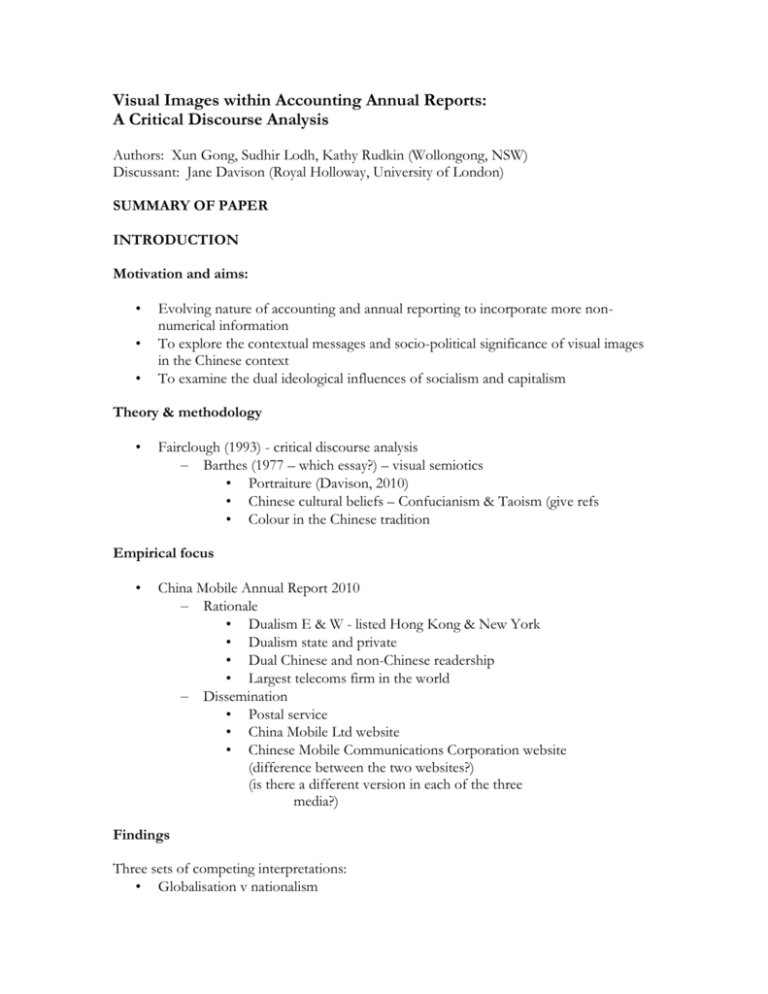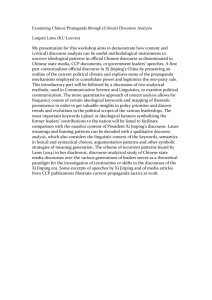view comments - Cardiff Business School
advertisement

Visual Images within Accounting Annual Reports: A Critical Discourse Analysis Authors: Xun Gong, Sudhir Lodh, Kathy Rudkin (Wollongong, NSW) Discussant: Jane Davison (Royal Holloway, University of London) SUMMARY OF PAPER INTRODUCTION Motivation and aims: • • • Evolving nature of accounting and annual reporting to incorporate more nonnumerical information To explore the contextual messages and socio-political significance of visual images in the Chinese context To examine the dual ideological influences of socialism and capitalism Theory & methodology • Fairclough (1993) - critical discourse analysis – Barthes (1977 – which essay?) – visual semiotics • Portraiture (Davison, 2010) • Chinese cultural beliefs – Confucianism & Taoism (give refs • Colour in the Chinese tradition Empirical focus • China Mobile Annual Report 2010 – Rationale • Dualism E & W - listed Hong Kong & New York • Dualism state and private • Dual Chinese and non-Chinese readership • Largest telecoms firm in the world – Dissemination • Postal service • China Mobile Ltd website • Chinese Mobile Communications Corporation website (difference between the two websites?) (is there a different version in each of the three media?) Findings Three sets of competing interpretations: • Globalisation v nationalism • • Democracy v dictatorship Shareholder interest v stakeholder interest v stateholder interest Postal service annual reports and China Mobile Ltd website indicate globalisation, democracy, shareholder interest China Mobile Communications Corporation website indicates nationalism, dictatorship and stateholder interest. Contribution • • • • (1) Ideology - first study of dual ideological implications of an annual report’s visual discourse for both socialism and capitalism (2) Method - combines critical discourse analysis with Barthes’ semiotics (3) Method - combines arts disciplines (portraiture, antithesis, repetition) and Chinese cultural beliefs and use of colour (these too may be studied under arts disciplines?) Add a fourth – detailed study of the Chinese context? LITERATURE REVIEW Key prior work – Preston et al. (1996) – Graves et al. (1996) – Preston and Young (2000) – AAAJ special issue (2009) – Davison (2010) Brief categorisation – Quantitative and content analysis – Qualitative – art theories, sociology – Gap re history, power and politics – Gap re Chinese context THEORY AND METHODOLOGY Detailed theory and methodology: critical discourse analysis • • • Language as social practice with political implications Includes discourse beyond the linguistic, such as body gestures and visual images Three-dimensional framework – Public discourse – visual in annual reports [pp. 10-38] – Discourse practice – regulation, dissemination, readership – Social practice – institutions and governance of the telecoms industry and China Mobile [pp. 38-39 Detailed theory and methodology: nothing on the visual?? EMPIRICAL WORK Public discourse: denotation ‘literal’ • • The waves’ representation of old & new, past & present, disruptive & sustaining (are these ‘literal’ meanings?) Use of repetition (is this denotation?) Public discourse: connotation ‘symbolic’ • (1) Waves – strategic direction & solid foundations (evidence?) (2) Water symbolism & Chinese culture - – sustainability (Taoism, kindness) & (Confucianism dynamic, wisdom): sustainability & democratic management (farfetched?) • (3) Use of colour & Chinese culture – Front cover – many colours - blurs east & west (far-fetched?) Portrait of chairman – yellow, purple – Qing dynasty power and dictatorship v Western symbolism of quality & trust (4) Awards Use of antithesis – blurred v concrete Use of repetition – emphasis of prizes (5) Director biographies Portraiture codes: Physical – attractiveness & success Dress – power & social status; western Interpersonal – smiles & charisma Spatial – same backcloth – consistency & solidarity Overall – globalised, charismatic, trustworthy, united. (?) Other aspects, eg repetition, diversity, government control (text) (6) Open dialogue with senior management Open and authoritative management Global corporate identity Centralisation & suppression – dominance of upper figure Social practice and discourse practice This work is in another paper STRENGTHS • • • • More work on the visual welcome. Analysis of ideology in visual images of annual reports – undeveloped as it stands, but if developed this would be an interesting contribution. Focus on China – despite the growth of China and Chinese accounting, there is almost no work on the use of the visual in Chinese annual reports. Placing in theory – not easy in visual work. SUGGESTIONS FOR IMPROVEMENT • • • • Literature review – better quality and accuracy of analysis, and tying in to subsequent empirical work Theory & methodology, especially visual theory & methodology – Closer discussion of critical discourse analysis – Closer discussion of the nature and challenges of the visual – almost nothing at present. – Closer discussion of the precise methods employed, eg. more precision re Barthes – Barthes (1977) is a collection of quite different essays – Too many approaches at present – confusion and overlap between CDA and semiotics, signifier/signified, denotation/connotation, rhetoric [antithesis & repetition], visual portraiture – What is uniquely Chinese in the visual? Empirical analysis – Sometimes the claims seem far-fetched and lacking in evidence – Tie in with literature review – Categories of analysis not logically constructed Length & structure – Overall structure well sign-posted in introduction. Too long at 20,000 words. Unbalanced between sections. Main arguments get lost. Repetition between sections. No real conclusions at present. FURTHER RESOURCES • • • • • inVisio [International Network for Visual Studies in Organizations] at: in-visio.org Newly available ESRC-funded research development web pages http://moodle.invisio.org/ Journal special issues AOS 1996; AAAJ 2009; QROM 2012 Books: Imagining Business (Routledge 2012) (Eds. Quattrone, McLean, Thrift); The Visual Organization (Routledge 2013) (Eds. Bell, Schroeder, Warren); Companion to Accounting Communication (Routledge, 2013) (Eds Jack, Davison, Craig) Conference at Essex University 27-28th November 2012





